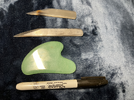sign216
Member
How can I sand or steel wool irregularities on an in-process oil finish, without removing gloss or causing whisk marks, and setting back the semi-gloss finish?
I'm applying a tung oil + solvent mix on a new walnut stock (Birchwood Casey Genuine Oil). Sometimes I get small projections on the stock as it cures between coats. I've burnished them off in the past with coarse burlap or 0000 steel wool, but both knock back the finish I've built up. Like it's one step forward, one step back.
I'm applying a tung oil + solvent mix on a new walnut stock (Birchwood Casey Genuine Oil). Sometimes I get small projections on the stock as it cures between coats. I've burnished them off in the past with coarse burlap or 0000 steel wool, but both knock back the finish I've built up. Like it's one step forward, one step back.


